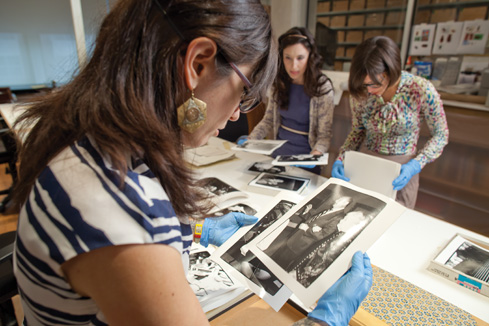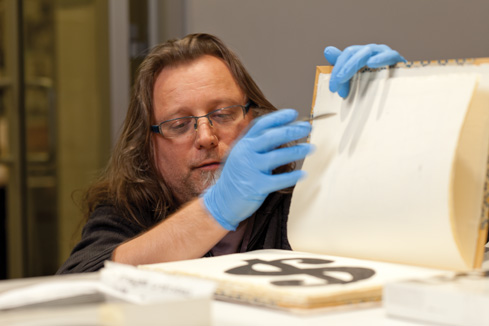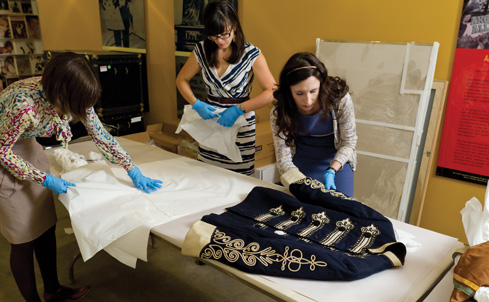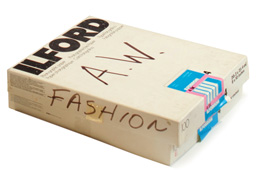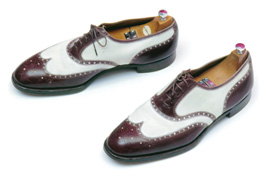 |
||||||
|
Photography by Joshua Franzos
|
Unpacking Andy
Each time Warhol cataloguers open another of Andy’s Time Capsules, they learn a little something new about the man behind the icon. And sometimes, they hit true Warhol pay dirt. Andy Warhol was the ultimate pack rat, stashing stuff from The Factory into his famed Time Capsules. He hoarded the mundane (direct-mail fliers), the ridiculous (greasy matted wigs) and the sublime (mint-condition Clark Gable shoes). For the past year, Elaina Vitale, a cataloguer at The Andy Warhol Museum, has been unearthing hundreds of Warhol’s personal possessions as she helps sort and categorize the contents of the Time Capsules. But nothing prepared her for the thrill of November 29, when she climbed a ladder and peered inside Time Capsule 577, the bottom drawer of a white, two-drawer filing cabinet stored high on a shelf in the museum’s third-floor archive. Lifting from it a black-and-white photograph, she quickly discovered hundreds of others, immortalizing Warhol and his socialite friends in a trail of hipster glory. At the bottom of the stack was a black leather-bound sketchbook, made by the Italian luxury goods company Bottega Veneta, with black dollar signs sketched by Warhol himself on the first five pages.
Left to right: Marie Elia, Erin Byrne, and Elaine Vitale dig through Time Capsule 577.As Vitale wheeled the photographs out into the hallway, she ran into Matt Wrbican, The Warhol’s chief archivist. “Look at what we found,” she urged. Wrbican figured maybe she was excited over a new photograph of Andy with a celebrity. But when he glanced down at the stash of Warhol images, his eyes widened. He couldn’t believe it. Accompanying the photographs were rarer finds yet: their negatives and marked-up contact sheets, making it an even more enduring archive of the pop artist’s personal life and the contemporary art scene of the 1980s. Filled with an estimated 800 to 1,000 photographs, this single Time Capsule nearly doubled the museum’s black-and-white photography collection. “I would have never guessed that an entire Time Capsule would be full of Warhol photographs,” says Wrbican. “It’s like striking gold.” One image shows Warhol standing on the beach, wearing a New York Yankees hat, long-sleeved shirt, and necktie, next to a sign that reads, “Welcome to Palm Beach. Weather today is 70 degrees and sunny.” “He looks like a city rat,” Wrbican says. “It’s hilarious.” Another shot zooms in on a startled Warhol getting a pedicure, a fitting ritual for the artist with a foot fetish. Most of the images were captured by Christopher Makos, a photographer and frequent travel companion and employee of Warhol’s.
Andy gets a pedicure.There are no dates on the photographs but Wrbican traces them to the early 1980s because of the many shots of Jon Gould, Warhol’s boyfriend at the time. Gould is captured doing a handspring down the large staircase of Central Park. Other images feature Mick Jagger, his Rolling Stones bandmate Charlie Watts, model and socialite Jane Holzer, photographer Peter Beard, video producer Vincent Fremont, and other young and beautiful people hanging out at the Odeon Restaurant in Tribeca. In one shot, Jagger’s famously large lips slurp soup, which drips off his spoon.
Hoarding cultureTo those who say that the Time Capsules were Warhol’s joke on the art world, Wrbican counters there is too much serious art in Time Capsule 577 and others for them to be a grand prank. Time Capsule 577 is also an exhilarating high point in the painstaking job of sifting through thousands of Warhol’s personal and work items and preserving them for posterity. A compulsive collector of everything from Fiestaware to World’s Fair memorabilia to crime scene photographs, Warhol started filling his Time Capsules when he relocated his New York studio, moving from Midtown Manhattan to Union Square, in 1974. He would use a cardboard box next to his desk to stash work materials, correspondence, souvenirs, photographs, artwork, stamps, direct mail, food, and other scraps of consumer culture that inspired him. He would also dump in items from his proper East 66th Street townhome, which was overrun with such large piles of stuff that visitors would have to take refuge in the kitchen, says Wrbican. He hated letting anything go. Shelly Fremont, wife of Vincent Fremont, Warhol’s video producer and business manager, used to collect Trader Vic’s tiki bar glassware and store it in her husband’s office at The Factory. One day, when Vincent asked her to thin out her collection to free up space, she started tossing items out. “Every time Shelly put something in the garbage, Warhol would pick it out and put it in a Time Capsule,” Wrbican says.
Matt Wrbican examines a rare find: a black leather-bound sketchbook with dollar signs drawn by Warhol.Once a box was filled, it would be sealed, labeled, and moved to storage. Then he would start again, filling 612 Time Capsules from the early 1970s until his death in 1987. Early Time Capsules were cardboard boxes, but Warhol switched to two-drawer filing cabinets after visiting Yoko Ono and admiring her sleek organizational system. Time Capsule 577 is one of the 40 stored in white filing cabinets before Warhol, wanting a more mobile system, reverted back to boxes. The sheer volume of stuff shows the frenetic pace of Warhol and his associates. “If there’s a message in Warhol’s art, it’s work hard and have fun,” Wrbican says. “Or have fun while you work hard.”
“ I would have never guessed that an entire Time Capsule would be full of Warhol photographs. It’s like striking gold.”
- Matt Wrbican, The Warhol's chief archivistFred Hughes, who for a quarter century was Warhol’s business manager and executor of his estate, said that Warhol envisioned selling his Time Capsules at the Leo Castelli Gallery in Soho. Potential buyers would’ve scanned a wall filled with boxes, picked one out without seeing its contents, and paid a flat fee, which Warhol initially set at $1,000 but later jacked up to $4,000, Wrbican recounted. Had the gamble paid off, they would’ve opened the box and gawked at priceless art. Others might feel ripped off toting home a box of old newspaper clippings. “It would’ve been a bit like a grab bag at Christmas,” Wrbican says. But Warhol died before he ever sold a single Time Capsule, leaving the thrill of discovery to the staff at The Warhol. Because of Hughes’ story, which he shared with Warhol museum staff and board members in New York City before the museum opened in 1994, the museum considers the Time Capsules to be a single work of art with thousands of individual components, possibly one of the largest art works ever created. For this reason, they are treated differently than typical archival materials.
Road kill to richesOver the last four years, The Warhol has made a big push to catalogue the Time Capsules, one by one, thanks to a sixyear, $650,000 grant from The Warhol Foundation made in 2008. Three cataloguers—Vitale, Marie Elia and Erin Byrne— all librarians by training, meticulously unfurl, sort, and label each item. The public will be able to see much more of their contents—some of which are on display at The Warhol and in traveling exhibitions around the world—once they’re catalogued. Also in the works by the museum: a Time Capsules mobile app, which will give users the thrill of virtually lifting the lid on Warhol’s treasures.
“If there’s a message in Warhol’s art, it’s work hard and have fun. Or have fun while you work hard.”
- Matt Wrbican, The Warhol's chief archivistAt the start of the project, Wrbican figured they’d be able to catalogue the yet-tobe- sorted 500 Time Capsules over six years. But as cataloguers soon learned, Warhol would sometimes stuff 600 or more items into a single Time Capsule. As of mid-January, the trio of full-time cataloguers had another 209 Time Capsules left to go, detailed work that will certainly require additional time and funding to complete. Archiving a Time Capsule is more labor intensive than other archives because every attempt is made to preserve every single item, no matter how trivial. Consider the old band uniforms, New York Police Department uniform, and old dress jacket trimmed with brass braids and buttons recently unearthed from the only Time Capsule stored in a large, incredibly heavy, black trunk filled with a whopping 3,000- plus items.
The team of cataloguers prepares a marching band jacket owned by Warhol to be placed back inside a Time Capsule. Below, Warhol sports the jacket inside a used clothing store in New York City in 1966.“Because Time Capsules are different from other objects, you have to preserve things like a hanger,” explains Amber Morgan, associate registrar at The Warhol. “We wrap it in tissue paper, so there is no chance of it snagging or catching on anything, and there is no chance of it getting rust on the jackets. We even keep the plastic dry cleaning bag a jacket came in, number it, catalogue it, and preserve it.” Staff also places tiny disks of Mylar under every last button so they don’t rust and stain the jacket.
Warhol also hoarded hundreds of stamps from the letters his friends sent him from overseas and a vast collection of direct mail. “He is probably the only person in the world who saved his direct mail,” says Wrbican. “If anyone wants to research direct mail from the mid- to late-20th century, we’re the place.” If some items are common or gag-inducing, others are beautiful, including the flowered scarves of his mother, Julia, and the immaculate pair of brown-and-white wingtips once owned by Clark Gable, handmade in England, complete with shoe trees. Another great find was a collage of letters and numbers made by Warhol friend David Hays that Warhol used in 1963 to create an album jacket that mimics a simple supermarket sign. Other notables include signed records by the Ramones and early press releases for the Red Hot Chili Peppers during the band’s push to become famous.
“Yes, they’re full of Warhol stuff,” says Morgan. “But if you don’t like Warhol or you are indifferent to Andy Warhol, there still might be a Time Capsule you would find cool. Warhol would take flights on the Concorde and swipe everything— the little napkins and silverware and salt and pepper shakers. Maybe you’re interested in the history of flights on the Concorde. Or maybe you are interested in politics and will look at elections from the 1970s. We have the newspaper headlines. And, obviously, if you’re into Campbell’s Soup, we have that, too.” Warhol also left a paper trail of unpaid bills. The most famous is from Dr. Giuseppe Rossi, the surgeon who saved the artist’s life after he was shot in 1968. He ignored several invoices for a bill that included several weeks in the hospital and an extra charge for a color TV in his room. “Pay up you blowhard,” Rossi wrote on the envelope of one bill, an amusing artifact that Wrbican shared with First Lady Michelle Obama when she toured The Warhol in 2009 while in Pittsburgh for the G-20 Summit. But if Warhol was a slacker on bills, he was also generous, leaving behind correspondence thanking him for the paintings and other donations he made to charities. Such important paperwork was stashed in the Time Capsules because of the sheer chaos of the office records at The Factory. “They didn’t understand how to put together a normal office filing system,” Wrbican says. “They didn’t have one. The Time Capsules were the office filing system. Who had time for organization? They were busy. They had places to go and people to meet and parties to attend and art to make.”
|
|||||
Crossroads of Culture · Picturing Me · The Galloping Ghost of the East Coast · President's Note · NewsWorthy · Face Time: Kota Yamazaki · Artistic License: For Nature's Sake · Science & Nature: Domino Effect · First Person: Dine and Discuss · The Big Picture
 |
Copyright © 2017 CARNEGIE Magazine. All rights reserved. |

